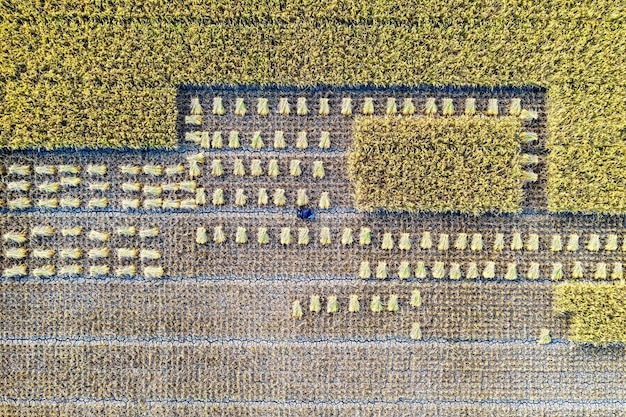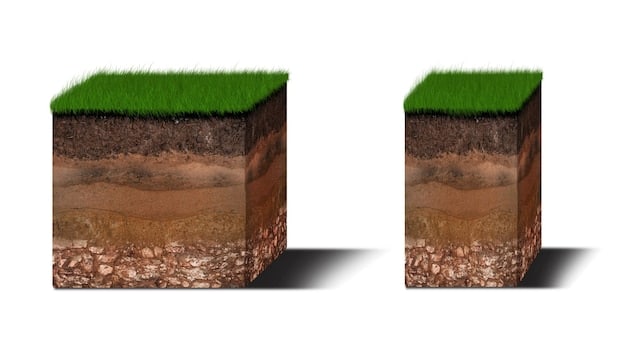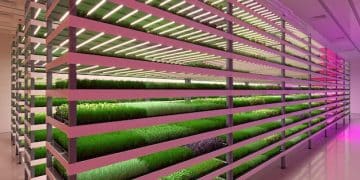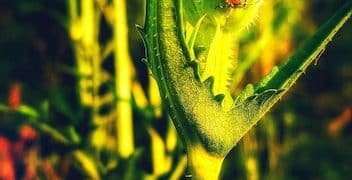Sustainable Agriculture: Producing More Food, Less Impact

Sustainable agriculture employs scientific methods to boost food production while minimizing environmental harm through practices like crop rotation, conservation tillage, and integrated pest management.
The science of sustainable agriculture: How Can We Produce More Food with Less Environmental Impact? is about balancing the need for food with the need to protect our planet. Sustainable agriculture uses innovative and effective ways to minimize environmental impact.
Understanding the Principles of Sustainable Agriculture
Sustainable agriculture is crucial for ensuring food security while preserving the environment. It involves practices that are economically viable, environmentally sound, and socially responsible. Understanding these principles is the first step toward creating a more sustainable food system.
Ecological Balance
Maintaining ecological balance is fundamental to sustainable agriculture. This involves promoting biodiversity, conserving natural resources, and minimizing pollution. Healthy ecosystems support agricultural productivity by providing essential services like pollination, pest control, and nutrient cycling.
- Promoting Biodiversity: Encouraging a variety of plant and animal species on farms to enhance ecosystem resilience.
- Conserving Natural Resources: Using water and soil resources efficiently to prevent depletion and degradation.
- Minimizing Pollution: Reducing the use of synthetic fertilizers and pesticides to protect water and air quality.
Economic Viability
For sustainable agriculture to succeed, it must be economically viable for farmers. This means adopting practices that are cost-effective, increase productivity, and provide access to markets. Supporting farmers through fair prices, incentives, and technical assistance is essential.
- Cost-Effective Practices: Implementing methods that reduce input costs and improve efficiency.
- Increased Productivity: Using innovative techniques to enhance crop yields and livestock production.
- Access to Markets: Connecting farmers with consumers and markets that value sustainable products.

In summary, sustainable agriculture integrates ecological, economic, and social considerations to create a resilient and productive food system.
Crop Rotation and Diversification
Crop rotation and diversification are essential practices in sustainable agriculture. These techniques enhance soil health, reduce pest and disease pressure, and improve overall farm resilience. By varying crops and introducing diversity, farmers can create more stable and productive systems.
Benefits of Crop Rotation
Crop rotation involves planting different crops in a planned sequence on the same field. Crop rotation has several benefits, including improved soil structure, reduced pest and disease outbreaks, and enhanced nutrient availability.
- Improved Soil Structure: Different crops have different root systems that help to break up compacted soil and improve water infiltration.
- Reduced Pest and Disease Outbreaks: Rotating crops disrupts the life cycles of pests and pathogens, reducing their impact on crops.
- Enhanced Nutrient Availability: Legumes, for example, fix nitrogen in the soil, which can benefit subsequent crops.
Strategies for Crop Diversification
Crop diversification involves growing a variety of crops on the same farm. Having more crops can enhance resilience to pests, diseases, and climate variability. It also provides additional income opportunities for farmers.
- Intercropping: Growing two or more crops simultaneously in the same field to maximize resource use and reduce pest pressure.
- Agroforestry: Integrating trees and shrubs into agricultural systems to provide shade, windbreaks, and additional products like fruits and nuts.
- Cover Cropping: Planting crops specifically to improve soil health, suppress weeds, and prevent erosion.
Crop rotation and diversification are vital strategies for creating sustainable and resilient farming systems.
Conservation Tillage and Soil Health
Conservation tillage is a technique that reduces soil disturbance, promotes soil health, and conserves water. By minimizing tillage, farmers can protect the soil structure, reduce erosion, and enhance carbon sequestration. Healthy soils are essential for sustainable agriculture because they provide nutrients, water, and support for plant growth.
Advantages of Conservation Tillage
Conservation tillage methods include no-till farming, reduced tillage, and strip-till farming. These practices offer numerous advantages for soil health and environmental sustainability.
- Reduced Soil Erosion: Minimizing soil disturbance prevents soil from being carried away by wind and water.
- Enhanced Water Conservation: Keeping crop residue on the soil surface reduces evaporation and increases water infiltration.
- Increased Carbon Sequestration: Reducing tillage allows the accumulation of organic matter in the soil, which stores carbon and reduces greenhouse gas emissions.
Practices for Improving Soil Health
Improving soil health is crucial for sustainable agriculture. Soil health practices include adding organic matter, promoting microbial activity, and reducing soil compaction. These practices enhance the soil’s ability to support plant growth and withstand environmental stresses.

- Adding Organic Matter: Incorporating compost, manure, and cover crops into the soil to improve its structure and fertility.
- Promoting Microbial Activity: Encouraging the growth of beneficial microorganisms in the soil to enhance nutrient cycling and disease suppression.
- Reducing Soil Compaction: Avoiding heavy machinery and excessive tillage to prevent soil from becoming compacted and restricting root growth.
Conservation tillage and soil health practices are essential for building resilient and sustainable agricultural systems that improve soil productivity and protect the environment.
Integrated Pest Management (IPM)
Integrated Pest Management (IPM) is a holistic approach to pest control that minimizes the use of synthetic pesticides. IPM emphasizes prevention, monitoring, and the use of biological and cultural control methods. By integrating multiple strategies, farmers can manage pests effectively while reducing environmental and health risks.
Principles of IPM
IPM involves a combination of strategies, including cultural practices, biological control, and targeted pesticide applications. The principles of IPM include:
- Prevention: Using cultural practices to prevent pest outbreaks, such as crop rotation, sanitation, and resistant varieties.
- Monitoring: Regularly monitoring pest populations to determine when intervention is necessary.
- Biological Control: Using natural enemies of pests, such as predatory insects, parasitic wasps, and microbial pathogens.
Techniques for Pest Control
IPM employs a variety of pest control techniques to minimize reliance on synthetic pesticides. These techniques include:
- Cultural Practices: Implementing farming practices that disrupt pest life cycles and reduce their impact on crops.
- Biological Control: Introducing or enhancing populations of natural enemies to suppress pest populations.
- Targeted Pesticide Applications: Using pesticides only when necessary and selecting products that are least harmful to beneficial organisms and the environment.
IPM is a key component of sustainable agriculture, enabling farmers to manage pests effectively while minimizing environmental and health risks.
Water Management and Irrigation Techniques
Efficient water management is essential for sustainable agriculture, particularly in regions facing water scarcity. Water management also plays a key part when considering
The Science of Sustainable Agriculture: How Can We Produce More Food with Less Environmental Impact?. Sustainable irrigation techniques aim to reduce water consumption, improve water use efficiency, and minimize environmental impacts. By implementing these practices, farmers can conserve water resources and ensure the long-term sustainability of their operations.
Sustainable Irrigation Methods
Drip irrigation and precision irrigation are two sustainable methods that deliver water directly to plant roots, reducing water loss through evaporation and runoff. These methods can significantly improve water use efficiency and crop yields.
- Drip Irrigation: Delivering water directly to plant roots through a network of tubes and emitters, reducing water loss and minimizing weed growth.
- Precision Irrigation: Using sensors and data analytics to monitor soil moisture levels. These allow for adjusting irrigation schedules to match crop water, maximizing water use efficiency.
Water Conservation Practices
In addition to efficient irrigation techniques, many other water conservation practices help improve water use efficiency and reduce environmental impacts. These practices include:
- Rainwater Harvesting: Collecting rainwater for irrigation and other uses, reducing reliance on groundwater and surface water sources.
- Water Recycling: Treating and reusing wastewater for irrigation, conserving water and reducing pollution.
- Soil Moisture Monitoring: Using sensors and other tools to monitor soil moisture levels, allowing farmers to optimize irrigation schedules and minimize water waste.
Water management and sustainable irrigation techniques are critical for ensuring the efficient and responsible use of water resources in agriculture.
The Role of Technology in Sustainable Agriculture
Technology plays a crucial role in advancing sustainable agriculture. Modern technologies offer innovative solutions for monitoring crop health, optimizing resource use, and improving farm management. By embracing technology, farmers can increase their efficiency, reduce their environmental impact, and enhance the sustainability of their operations.
Precision Farming Technologies
Precision farming technologies, such as GPS mapping, remote sensing, and variable rate application, enable farmers to manage their fields with greater accuracy and efficiency. These technologies allow farmers to optimize their inputs, reduce waste, and minimize environmental impacts.
- GPS Mapping: Creating detailed maps of fields to identify variations in soil type, nutrient levels, and pest infestations.
- Remote Sensing: Using drones and satellites to monitor crop health and identify areas that need attention.
- Variable Rate Application: Adjusting the application of fertilizers, pesticides, and water based on real-time data, minimizing waste and reducing environmental impacts.
Data Analytics and Decision Support
Data analytics and decision support tools help farmers analyze large volumes of data to make informed decisions. These tools can assist with crop selection, irrigation scheduling, and pest management, improving overall farm efficiency and sustainability.
- Crop Modeling: Simulating crop growth and development to predict yield and optimize management practices.
- Weather Forecasting: Utilizing weather data to plan planting, irrigation, and harvesting activities, reducing risks and maximizing productivity.
- Decision Support Systems: Providing farmers with recommendations based on data analysis, helping them make informed decisions about crop management and resource allocation.
Technology is a game-changer for sustainable agriculture, empowering farmers to make data-driven decisions that improve efficiency, reduce environmental impact, and enhance the sustainability of their operations. It is an important aspect when considering The Science of Sustainable Agriculture: How Can We Produce More Food with Less Environmental Impact?.
| Key Point | Brief Description |
|---|---|
| 🌱 Crop Rotation | Rotating crops enhances soil health and reduces pests. |
| 💧 Water Management | Efficient irrigation reduces water waste. |
| 🚜 Conservation Tillage | Reduces soil erosion and improves carbon sequestration. |
| 🐛 Integrated Pest Management | Controls pests with minimal synthetic pesticide use. |
Frequently Asked Questions
▼
Sustainable agriculture aims to produce food in a manner that is environmentally sound, economically viable, and socially responsible. It seeks to meet current food needs without compromising the ability of future generations to do the same.
▼
Soil health is crucial because it affects the ability of the soil to support plant growth, store water, and cycle nutrients. Improving soil health enhances productivity and also reduces the need for synthetic fertilizers and pesticides.
▼
Crop rotation enhances soil health by improving soil structure, reducing pest and disease outbreaks, and enhancing nutrient availability. It also minimizes the reliance on synthetic inputs and increases overall farm resilience.
▼
Technology enables farmers to monitor crop health, optimize resource use, and improve farm management. Precision farming technologies, data analytics, and decision support tools help farmers make informed choices that enhance sustainability.
▼
Sustainable irrigation techniques include drip irrigation and precision irrigation. These methods deliver water directly to plant roots, and reduce water loss through evaporation and runoff. These techinques improve water use efficiency and crop yields.
Conclusion
In conclusion, the science of sustainable agriculture offers a path towards producing more food with less environmental impact. By embracing practices like crop rotation, conservation tillage, integrated pest management, efficient water management, and technology, we can create a more resilient and sustainable food system that benefits both people and the planet.





